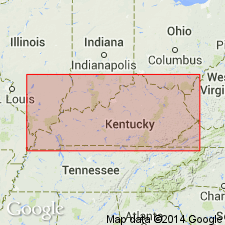
- Usage in publication:
-
- Oldham limestone
- Modifications:
-
- First used
- Dominant lithology:
-
- Limestone
- Shale
- AAPG geologic province:
-
- Cincinnati arch
Summary:
Pg. 145. See also entry under Foerste (1906). Oldham limestone. Is upper of two beds in the Indian Fields formation; lower bed is Plum Creek clay.
[According to GNU records (USGS DDS-6; Reston GNULEX, Mar. 24, 1987), this is "first published use" of the Oldham; proposal did not meet nomenclatural guidelines (shown on stratigraphic table).]
Source: Modified from GNU records (USGS DDS-6; Reston GNULEX).
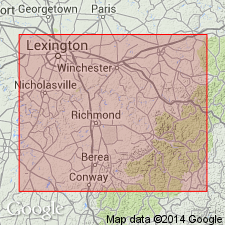
- Usage in publication:
-
- Oldham limestone
- Modifications:
-
- Named
- Dominant lithology:
-
- Limestone
- Shale
- AAPG geologic province:
-
- Cincinnati arch
Summary:
Pg. 10, 47; also 1905, Kentucky Geol. Survey Bull., no. 6, p. 145. Oldham limestone. Fossiliferous limestone, 10 to 14 feet thick, forming upper member of Indian Fields formation. Lower 1 to 3 feet composed of limestone and interbedded clay overlain by limestone with much less clay. Contains diagnostic brachiopod STRICKLANDIA NORWOODI in uppermost part. Underlies Alger formation and overlies Plum Creek clay (member of Indian Fields formation). All of Niagaran age. [In 1931 (Kentucky Geol. Survey, ser. 6, v. 36, p. 172, 173) Foerste assigned this limestone to Clinton time. In 1935 (Denison Univ. Bull., Sci. Lab. Jour., v. 30, p. 130-133) he amplified his description of this limestone and stated it is probably older than Dayton limestone.]
[Type section: cuts along Louisville and Atlantic RR between Panola and Brassfield where the railroad follows the northern slope of the valley of Oldham Branch, Madison Co., east-central KY (GNU records, USGS DDS-6; Reston GNULEX).] Named for Oldham Branch, between Panola and Brassfield, Madison Co., east-central KY.
Source: US geologic names lexicon (USGS Bull. 896, p. 1542); supplemental information from GNU records (USGS DDS-6; Reston GNULEX).
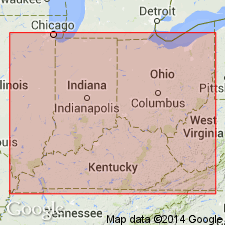
- Usage in publication:
-
- Oldham Limestone Member
- Modifications:
-
- Revised
- AAPG geologic province:
-
- Cincinnati arch
Summary:
Reassigned as Oldham Limestone Member to Noland Formation (new) of Crab Orchard Group. At type section consists of about 10 ft of thin- to medium-bedded impure dolomitic limestone and varying amounts of interbedded shale. Overlies Plum Creek Clay Member; underlies Lulbegrud Shale Member. North of Bath Co., dolomitic limestones of the Noland occupy stratigraphic position of the Oldham, but they are shaly and are not certainly identifiable as Oldham.
Source: GNU records (USGS DDS-6; Reston GNULEX).
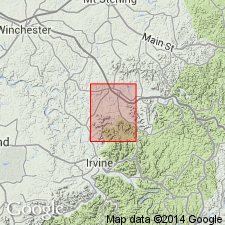
- Usage in publication:
-
- Oldham Member*
- Modifications:
-
- Revised
- AAPG geologic province:
-
- Cincinnati arch
Summary:
Reassigned as Oldham Member of Crab Orchard Formation.
Source: GNU records (USGS DDS-6; Reston GNULEX).
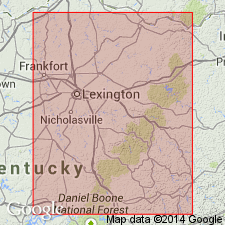
- Usage in publication:
-
- Oldham Member*
- Modifications:
-
- Revised
- AAPG geologic province:
-
- Cincinnati arch
Summary:
Oldham Member reassigned to Drowning Creek Formation (new) of Crab Orchard Group. Oldham is composed of interbedded dolomite and shale. The dolomite, about 60 to 80 percent of the unit, is gray, fine- to coarse-grained, commonly fossiliferous, and locally calcitic. The shale is greenish-gray, plastic when wet, and poorly fissile. The dolomite occurs in even to irregular beds from 1 in. to 1 ft, most commonly about 2 in. thick. The interbedded shale is in beds as much as 1 ft thick but most commonly occurs as partings or beds 1 to 2 in. thick. Unit ranges in thickness from about 3 to 15 ft but is about 7 to 12 ft thick in most places. Underlain by Plum Creek Shale Member and overlain by Lulbegrud Shale Member, both of Drowning Creek Formation.
Source: GNU records (USGS DDS-6; Reston GNULEX).
For more information, please contact Nancy Stamm, Geologic Names Committee Secretary.
Asterisk (*) indicates published by U.S. Geological Survey authors.
"No current usage" (†) implies that a name has been abandoned or has fallen into disuse. Former usage and, if known, replacement name given in parentheses ( ).
Slash (/) indicates name conflicts with nomenclatural guidelines (CSN, 1933; ACSN, 1961, 1970; NACSN, 1983, 2005, 2021). May be explained within brackets ([ ]).

